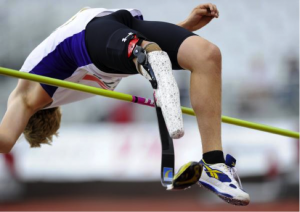 This inspiring picture of a para-athlete should remind us all of what those with “disabilities” as defined by the law can achieve. It should also make the courts consider whether they have mis-construed the law concerning injury under the ADA. I’ve written many times before about the troubling tendency of some courts to ignore the actual injury requirement for lawsuits under the ADA. (See my posts on December 23, 2013, October 3, 2013, May, 2013 and especially Nov. 6, 2013). A recent decision from North Carolina shows how one court, at least, has adopted the common sense view that a plaintiff who has not been injured cannot maintain an action under the ADA. Blue v. Boddie-Noell Enterprises, Inc., 2015 WL 509831 (E.D.N.C. Feb. 6, 2015).
This inspiring picture of a para-athlete should remind us all of what those with “disabilities” as defined by the law can achieve. It should also make the courts consider whether they have mis-construed the law concerning injury under the ADA. I’ve written many times before about the troubling tendency of some courts to ignore the actual injury requirement for lawsuits under the ADA. (See my posts on December 23, 2013, October 3, 2013, May, 2013 and especially Nov. 6, 2013). A recent decision from North Carolina shows how one court, at least, has adopted the common sense view that a plaintiff who has not been injured cannot maintain an action under the ADA. Blue v. Boddie-Noell Enterprises, Inc., 2015 WL 509831 (E.D.N.C. Feb. 6, 2015).
The ADA itself creates a cause of action for “any person who is being subjected to discrimination on the basis of disability” 42 U.S.C.A. § 12188. “Discrimination” means denial of the “full and equal enjoyment” of goods and services, but the specific definition for accessible facilities is curiously impersonal. Discrimination is defined as the failure to remove barriers to access or failure to construct according to the guidelines without reference to whether any disabled person ever visits the facility. One might reasonably ask who is the victim of this kind of discrimination if no disabled person is affected by the barriers to access.
While the definition of discrimination is impersonal, standing to file suit certainly requires an actual injury, and this is the point at which the courts enforcing the ADA often focus more on public policy concerns than constitutional requirements. Any number of courts, including especially the 9th and 11th Circuits, regard mere knowledge of a technical violation of the ADA Standards as an ADA injury, regardless of whether the non-compliant feature was really a barrier to access for the particular plaintiff. There is an intellectual disconnect in these holdings because the same courts require that the particular barrier relate to the plaintiff’s general category of disability (a blind person cannot sue because a ramp is too steep). If a blind person cannot be a victim of discrimination based on a barrier to access that affects a person in a wheelchair why can a person who needs a walker sue if the particular mobility barrier only affects those in wheelchairs? These same courts allow lawsuits regarding barriers to access never encountered by the plaintiff if the barrier is in the same facility as at least one barrier the plaintiff does encounter. As a way of enforcing the law by bringing lots of claims into one lawsuit this makes sense, but it shreds to ribbons the conventional notion of actual injury required for Article III standing.
The District Court in North Carolina has taken the step, which should not be extraordinary, of requiring actual injury. Dismissing the plaintiff’s discrimination claims the Court made this observation:
Plaintiff merely states that she had “difficulty” using the restroom and navigating the parking lot. [DE 1 at ¶ 4] She has failed to allege how the particular barriers that she encountered caused injury, what type of injury she suffered, or how she is likely to be discriminated against in the future by the same alleged violations.
The Court doesn’t provide much detail about what allegations would be sufficient, but it is clear that merely knowing about or confronting an “barrier to access” is not enough. This makes perfect sense. Although the regulations promulgated by the Department of Justice look a lot like a building code, discrimination can only occur when a disabled individual is actually denied the full and equal enjoyment of a facility, and that requires (or should require) an individual assessment of the plaintiff’s condition and the particular barrier to access in question. The DOJ insists that when it comes to reasonable accommodations every individual be treated as such, without stereotyping. The other side of the same coin must be that individuals be treated as individuals when they sue under the ADA, and that they not be allowed to sue based on barriers to access defined by their membership in a particular class of disabled individuals rather than their own particular disability.
My final observation, as always, concerns the long term avoidance of litigation. Winning an ADA lawsuit because the particular individual plaintiff could not establish standing or prove discrimination is not guarantee that another suit by a different plaintiff will also fail. The only long term solution for any business is to make sure that barriers to access are removed to the greatest extent possible. Aggressive defense without aggressive remediation only makes money for the lawyers. Still, it is good to know that some courts are willing to require real injury as a condition to a lawsuit under the ADA.

